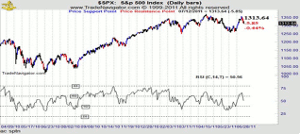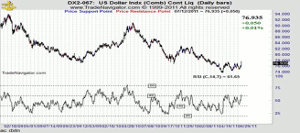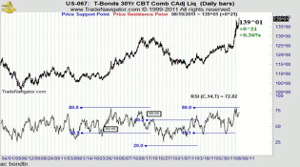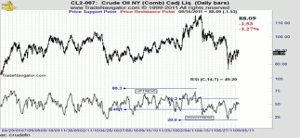One of its foremost experts, Andrew Cardwell of CardwellRSIEdge.com, offers words of wisdom on the optimal use of this classic trend indicator.
The ideal indicator would be one which offered the capability to identify and monitor the current trend, highlight overbought and oversold extremes within that trend, and give early warnings of a trend change. The Relative Strength Index (RSI) is such an indicator, offering the best of all worlds.
The RSI is probably one of the most dynamic and powerful indicators available to today’s traders. One of the most widely used, it is available on almost every technical analysis software program. It is also one that is most often misunderstood, misused, and underrated. The RSI can be used as either a completely independent trading model or an enhancement of your current technical approach. As a completely independent trading program it can be used for identifying: Trend, Support and Resistance, Overbought/Oversold Levels, Divergence (Bullish/Bearish), Trend Change and Reversal, and Price Targeting.
Most technical indicators employed by traders can, in general, be categorized as either trading or trending technical studies. Momentum oscillators are usually considered to be trading indicators, as they use market volatility to identify overbought or oversold valuation levels. Moving average systems would be considered trending studies, as they smooth volatility to help identify and monitor the current trend. Of course, the length of the moving average selected, or time period assigned to the oscillator used, should be predicated on whether it is for shorter term or longer term trading.
Divergence
The RSI was originally developed by Wells Wider (Trend research, Hendersonville NC) in the late 1970’s. It was designed as a momentum oscillator to help identify divergences (non-confirmations) between price movement and momentum. The basic premise was twofold:
- 1. That momentum would peak before price in an uptrend or bottom first in a downtrend,
- After a correction as price made a new high (or low), momentum would fail to make a new high (or low), and not confirm the new price movements.
This non-confirmation is characteristic of most momentum-based indicators and has been duly noted and accepted as divergence. Basic price/momentum divergence can and does help to identify an extreme overbought or oversold condition in the market’s momentum. However, most traders fall prey to this concept of divergence and see it as the end or reversal of the prevailing trend of the market. When bearish divergence develops, the bears come out of hibernation and want to sink their claws into what they feel will be the next bear market. As bullish divergence develops, the bulls are ready for a reversal of trend and the start of a bullish stampede to the upside.
NEXT PAGE: Importance of Trend |pagebreak|
All would be right with the world if markets were to reverse from simple divergence. But there are times when sentiment and momentum are so strong that the market continues to make new highs (lows), which will keep the RSI at overbought (oversold) levels for extended periods of time. Momentum and price corrections, when they do materialize, are usually sharp and swift. After these brief respites the market is then ready to resume its normal upward (downward) trend. With each successive new high (low) and divergence formed, anxious traders are ready to call for a top (bottom) and reversal of trend. However, in strongly trending markets, multiple divergences can and do develop, which only lead to corrections of the overbought (oversold) condition of the market. If a trader attempted to take positions based solely on divergences, he or she would need deep pockets and eventually exhaust his or her trading capital.
Importance of Trend
Most traders and analysts use RSI as an oscillator to identify overbought/oversold levels and divergences, but those are just two of its analytical applications. The RSI’s more dynamic and significant contributions as a tool are its ability to:
- Identify the current trend and keep the trader positioned property in the direction of that trend; and,
- When market conditions develop, give early warning of a possible impending trend change, whereby the trader can reverse the position.
Since markets generally trend approximately 60-70% of the time, trend analysis, identification and change should be foremost in the mind of the trader. The ability to recognize a trend change quickly, reverse a position, and trade in the direction of that next trend is the skill which traders must develop to be successful.
By having a position in tune with the trend, the trader will have the opportunity to participate in the bigger market moves, which generate larger profits. When positioned properly with the trend there are also fewer trading decisions that have to be made. Since markets trend, any surprises which may develop in market activity are usually in the direction of the intermediate and longer term trends.
RSI Ranges
The parameters for the RSI values are 0-100. Extremes for overbought and oversold levels vary slightly, depending on the period value selected by the trader’s perspective. Day traders or shorter-term traders will generally employ values such 3, 5, 7, or 9, and longer term traders usually use either 9, 14, or 21. The original value of the period established by Welles Wilder was 14, which was based on being the half-cycle length of the 28 day or lunar cycle. Using the 14 period value on close as the standard for most of the markets we follow, we use the following as guidelines:
Ranges of RSI
- Normal Range: 30-70
- Uptrend (Bull Market): 40-80
- Downtrend (Bear Market): 20-60
- Trading Range: 40-50 points
NEXT PAGE: The 3 Keys to Success |pagebreak|
We consider the “normal” range to be the levels between 30 and 70, which is where 60-70% of trading activity takes place. When a market is in a gradual uptrend (or downtrend) the RSI will normally ebb and flow within this range as the market trends higher (or lower). The levels for an overbought market can range from 70 up to 80 or 90, depending on the time period selected. For an oversold market the range may be from 30 down to 20 or 10. Taking the average of the overbought and oversold values we established 80 and 20 as better values for consideration of overbought and oversold levels. The standard 14-period RSI normally stays within a range of80 and 20.
People are bullish by nature, so when markets start to move we must adjust for this shift in sentiment and psychology. When sentiment is extremely bullish, momentum takes prices to higher levels. We adjust the range of RSI to account for these higher levels. Using the same 40 point range based on the 30 and 70 point values, Uptrends show 80 as overbought and 40 as oversold. As long as the market stays within the 80/40 range (uptrends), we should see prices make higher highs and higher lows.
When sentiment is extremely bearish, momentum normally takes prices to lower levels due to liquidation and the absence of buying. Applying the same 40 point ranges for downtrends, 60 shows as overbought and 20 as oversold. As long as the range of 60/20 remains intact, we should continue to see lower lows and lower highs. Taking note that the range has shifted from 80/40 to 60/20 should be a strong indication that the trend has shifted from being in an uptrend to being in a downtrend. By employing range analysis to RSI, not only can a trader identify uptrends from downtrends, but he will also stay with the trend longer than he normally would have and hold a position for maximum capital appreciation.
As an exercise to further educate yourself, take the time to go back and review your trades over the last 6-12 months and apply the 80/40 and 60/20 range rules. You will probably realize that you were positioned properly in a trend, and even though you made money on the trade you offset the position much too soon. If you lost money on a trade, you were probably short in an uptrend (80/40) or long in a downtrend (60/20).
The 3 Keys to Success
If you include the guidelines, which I have presented here for RSI range analysis, I believe you will find that they will help you make better trading decisions and stay in tune with the trend. As a final note, always remember the “3 Keys to Success,” trading program, patience, and discipline. Follow your trading program, have the patience to wait for the signal, and the discipline to stay within the parameters of your program and stay within yourself.
Andrew Cardwell can be found at CardwellRSIEdge.com























